
Sometimes the drama of politics is fit for a movie script. One such chain of events began when the considerable phosphorus discharges of the fertilizer factory by the Luga River in Russia made the headlines.
At Finland’s initiative, the Baltic Marine Environment Protection Commission initiated a study where researchers of the Finnish Environment Institute investigated what the source of the nutrient load in Russia was. The massive discharges of the Luga River, in particular, had caused suspicion.
In January 2012, Helsingin Sanomat released the results of the study in a very visible manner, and revealed the source was in fact the Eurochem Fosforit fertilizer factory. Researcher Seppo Knuuttila commented that the discharges were massive.
AS A MINISTER, I had to make a choice. Some of our civil servants recommended caution. With Russia, things have traditionally been taken care of in the sidelines. But times have changed. Today, we need to discuss our problems openly. The Russians and the company cannot be pushed to a corner. If we blame our partners in negotiation, we will not reach a solution, but if we don’t underline the significance of finding a solution, our matter will not be given the weight it deserves.
During the same week, I invited the key Finnish stakeholders to the Ministry of the Environment. Our division of labour was clear.
As the next steps for the Protection Commission, I hastened the collection of further information on the precise location of the leak, after which it was to be blocked. In a letter to the Russian Ministry of Natural Resources and Environment, we offered our cooperation.
At the same time, we wanted to start working with the company immediately. The gypsum mountains of the factory area were a prime suspect for the source of the discharge. The role of the John Nurminen Foundation, which offered its knowhow to Eurochem, providing assistance in blocking the leaks, was essential.
THE NEXT CHAPTER IN THE DRAMA unfolded in April, when further samples were being collected. The Russian security services had arrested Seppo Knuuttila. According to the Russians, he had diverted from the agreed path when taking samples in the tightly-guarded area. The next days were filled with tension.
Some of the authorities were worried over what the Russians’ reaction would be. I have known Knuuttila for many years and I trusted him. My perspective was that the State of Finland will always defend its civil servants who are taking care of their official duties. We approached the Russians on the highest level of civil service. We steered clear of making this a political issue, which made it easier for the Russians to deal with the situation.
Although some materials were confiscated, Knuuttila was able to return to Finland. Judged by the nature of the interrogations and the arrest it was no coincidence that Knuuttila, who had been the source of the news on the leak in January, was the one who was arrested.
In the end, the pressure created by sample taking, cooperation amongst authorities, and the negotiations conducted by the Foundation in the sidelines led to a solution. Even though the company denied the existence of any discharges in public, it quickly began to sort the matter out. In early June, the Foundation and Eurochem could publicise the fact that the source of the discharge had been blocked. As a minister, I gave the Foundation my full support as we worked together on the matter in meetings that were almost weekly.
Without the persistent work of Seppo Knuuttila and the other researchers, this discharge would never have been discovered. Without the John Nurminen Foundation and its direct contact with the company, we might have spent years waiting for a solution. Without public pressure, the company would not have had the will to solve the matter.
In terms of the protection of the Baltic Sea, the results are wonderful. Phosphorus loads were decreased by 1,700 tonnes a year. As a result, the status of the Gulf of Finland, which has improved in recent years, will get an additional boost. But the work continues. Together with Poland, we are solving smaller potential sources of discharge.
As a minister of the environment, I am proud to be leading such a team, working for the protection of the Baltic Sea. When you are in the archipelago in the summertime, there is no doubt that this work is important.
